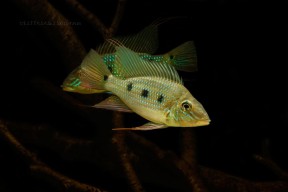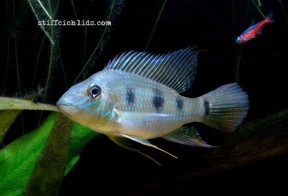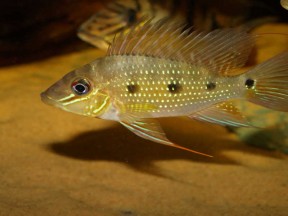Satanoperca acuticeps
Sharphead Eartheater
SynonymsTop ↑
Geophagus acuticeps Heckel, 1840
Etymology
Satanoperca: from the Ancient Greek Σατάν (Satán), meaning ‘Satan’ (the devil), and πέρκη (pérkē), meaning ‘perch’.
acuticeps: from the Latin acutus, meaning ‘sharp’, and -ceps, meaning ‘-headed’, in allusion to this species’ relatively pointed head shape.
Classification
Order: Perciformes Family: Cichlidae
Distribution
Native to the central Amazon basin in Brazil where it occurs in the Amazon main channel and lower basins of tributary drainages between the rios Tapajós and Tefé, including the lower rio Negro and its principal affluent the rio Branco, plus the rios Arapiuns, Trombetas, Mamuru, Curuçá, Urubu, and Purus.
Type locality is ‘Manaus, Brazil’.
Habitat
Tends to inhabit environments containing clear or turbid water rather than tannin-stained, nutrient-poor black water. It has been observed in main river channels, smaller tributaries and floodplain lakes, typically over substrates of sand or mud with patches of leaf litter and submerged tree branches.
In the lower rio Purus, sympatric species include Acarichthys heckelii, Apistogramma spp., Crenicichla inpa, C. regani, Laetacara thayeri, Symphysodon aequifasciatus, Uaru amphiacanthoides, Osteoglossum bicirrhosum, Crenuchus spilurus, Hemiodus spp., Carnegiella marthae, C. strigata, Axelrodia stigmatias, Gnathocharax steindachneri, Hemigrammus bellottii, H. hyanuary, H. ocellifer, H. schmardae, Hyphessobrycon copelandi, Iguanodectes spirulus, Paracheirodon innesi, Copella nattereri, Nannostomus eques, and various non-rheophilic loricariid catfishes.
Maximum Standard Length
140 – 170 mm.
Aquarium SizeTop ↑
An aquarium with a base measuring at least 180 ∗ 60 cm or equivalent is required.
Maintenance
Although this species is markedly less benthophagous than other members of the genus (see ‘Diet’) it does browse from the substrate at times, therefore a base layer of sand is recommended. Coarser materials such as gravel or small pebbles can inhibit feeding, damage gill filaments and even be ingested with the potential of internal damage or blockages.
Additional furnishings are as much a case of personal taste as anything else but the most favoured set-ups tend to feature relatively dim lighting plus some chunks of driftwood and scattered roots or branches.
Leaf litter is a typical feature of the natural environment but not really recommended in aquaria because the feeding behaviour of Satanoperca spp. tends to cause an excess of partially-decomposed material in suspension which not only looks unsightly but can block filter and pump mechanisms.
Water quality is of the utmost importance since these cichlids are extremely susceptible to deteriorating water quality and swings in chemical parameters so should never be introduced to a biologically immature aquarium.
The best way to achieve the desired stability is to filter the tank using a combination of external canister filters and/or a sump system and perform minimum weekly water changes of 50-70%.
If the maintenance regime is insufficient health issues such as head and lateral line erosion or stunted growth can occur.
Water Conditions
Temperature: 20 – 28 °C
pH: 5.5 – 7.5
Hardness: 36 – 215 ppm
Diet
S. acuticeps is unique within the genus in that it appears to be at least partially adapted to a pelagic existence rather than being a specialised benthivore. Its mouth position is terminal (vs. subterminal in all other Satanoperca species), lower lip fold continuous (vs. interrupted), and it possesses two (vs. one) series of teeth in the upper jaw.
It is omnivorous; the stomach contents of wild specimens comprise aquatic and terrestrial invertebrates including arthropods and insect larvae, plus significant quantities of zooplankton, phytoplankton, plant material, and organic detritus.
Even large individuals seem unable to properly ingest larger food items, meaning the captive diet should contain a variety of high quality, fine-grade prepared foods plus live or frozen Daphnia, Artemia, mosquito larvae, etc. At least some of the dried products should contain a high proportion of vegetable matter such as Spirulina or similar.
Home-made, gelatine-bound recipes containing a mixture of dried fish food, puréed shellfish, fresh fruit and vegetables, for example, are proven to work well and can be cut into bite-sized discs using the end of a sharp pipette or small knife.
Rather than a single large meal offer 3-4 smaller portions daily to allow natural browsing behaviour as this seems to result in the best growth rate and condition.
Behaviour and CompatibilityTop ↑
Unless breeding this species is surprisingly peaceful and will not predate on fishes larger than a few millimetres in length. Suitable tankmates are numerous and include most peaceful species enjoying similar environmental conditions. Best avoided are aggressive or territorial substrate-dwelling species, or those requiring less acidic or mineral-rich water.
Some aquarists keep Satanoperca spp. alongside freshwater stingrays of the genus Potamotrygon which in many cases has proven successful but in some has resulted in the cichlids disappearing at night.
S. acuticeps is gregarious and tends to exist in loose aggregations unless spawning, with juveniles in particular displaying strong grouping instincts. A group of 5-8 individuals should be the minimum purchase and these will form a noticeable dominance hierarchy. When maintained in smaller numbers weaker specimens can become the target of excessive antagonism by dominant individuals or the group may fail to settle and behave nervously.
Sexual Dimorphism
Aquarium observations suggest that males tend to grow slightly larger than females and develop longer filamentous extensions on the posterior dorsal-fin rays, while females become noticeably deeper-bodied when gravid.
Reproduction
This species is a biparental substrate-spawner, but is very rarely-bred in aquaria. There does not appear to be any particular trigger for the spawning process with the main requirements being sufficient space, suitable diet and a stringent maintenance regime.
Since accurate sexing is very difficult it is perhaps best to begin with a group of young fish and allow pairs to form naturally, while a degree of patience is also required since it can be at least a year until they become sexually mature.
A breeding pair will select a suitable site and excavate a large pit, within which spawning takes place, the female depositing batches of eggs with the male following in order to fertilise them. The adults tend to cover the brood with a thin layer of sand, and while both male and female participate in brood care it is the latter that spends the most time tending the eggs, while the male is also responsible for defence of the surrounding territory.
Incubation is 2-3 days, and post-hatching both adults normally continue to guard the fry for a period although in some cases the female continues alone. The fry are able to accept Artemia nauplii, microworm, etc. as soon as the free-swimming stage is reached. Alternatively, the eggs or fry can be siphoned out of the aquarium and raised elsewhere.
NotesTop ↑
This species is relatively rare in the ornamental trade where it is also known as ‘sparkling eartheater’ and ‘four-spot eartheater’.
It is sometimes confused with its similarly-patterned congeners S. daemon and S. lilith. These three species all possess 1-3 dark blotches on the side of the body and a relatively large ocellus on the upper caudal-fin base, characters that immediately separate them from the remainder of the genus which lack blotches on the body and have a relatively small ocellus on the upper caudal-fin base.
S. acuticeps is unique in possessing three flank blotches (vs. two in S. daemon, one in S. lilith), and also differs in a number of morphological characters (see below).
Satanoperca was considered a synonym of Geophagus for a number of decades before being revalidated by Kullander (1986). It is separated from all other members of the putative cichlid subfamily Geophaginae by presence of a small ocellated spot at the upper caudal-fin base, and from Geophagus by a number of morphological characters as follows: equal numbers of abdominal and caudal vertebrae or one more abdominal vertebra (vs. more caudal than abdominal vertebrae in Geophagus); no ribs on caudal vertebrae and no postabdominal swimbladder extensions (vs. presence of both in Geophagus; cheek scaled rostrally to centre (vs. naked on anterior half; dorsal and anal fins naked (vs. scaled); external gill rakers on lower limb of first gill arch attached to the skin covering the gill filaments (vs. attached to ceratobranchial skin); jaw dentition reduced to one or two short series in each jaw (vs. pluriseriate with wide band of inner teeth); absence (vs. presence) of tooth plates on 4th ceratobranchial; presence (vs. absence) of an ocellus on caudal-fin base; both or only upper lip fold continuous (vs. both interrupted anteriorly); preoperculum and supracleithrum frequently serrated (vs. entire); absence (vs. presence) of median hypural cartilage; 3 (vs. 4) infraorbitals.
The genus is likely to contain additional species, and has been separated into three groups with distinctive morphology, namely the S. jurupari group, the S. daemon group, and the monotypic S. acuticeps group.
Among these, members of the S. jurupari group are characterised by a colour pattern comprising a dark lateral stripe or row of blotches along the side of the body, normally XV.10 (XIV-XVII.8-11) dorsal-fin rays, normally 27 (26-28) E1 scales (the longitudinal row immediately above the lower lateral line, excluding the pectoral girdle), and 12-18 rakers on the first gill arch.
S. daemon group members grow larger than other congeners, possess one or two large dark blotches on the side of the body and a prominent ocellus at the upper caudal-fin base, usually XIX.13 (XII-XIV.12-14) dorsal-fin rays, 29-31 E1 scales, and 18-22 gill rakers. S. acuticeps is unique in that it has a relatively more terminal mouth than all other genus members, normally XIII.12 (XIII.11-12) dorsal-fin rays, 27-28 E1 scales, and 17-20 gill rakers.
The groups also differ in reproductive strategy, with the S. daemon and S. acuticeps assemblages being substrate spawners, and the S. jurupari group mouthbrooders.
The monophyly of the S. acuticeps group is well-supported in phylogenetic studies, although there appears to be some geographic genetic diversity, with a degree of separation between populations from the rios Maués and Purus, for example.
Satanoperca and a number of related genera are often included in the putative subfamily Geophaginae, and Kullander (1998) conducted a morphology-based phylogenetic study in which the neotropical Cichlidae was divided into six subfamilies of which the Geophaginae contained 16 genera divided among three ‘tribes’:
Acarichthyini – Acarichthys and Guianacara.
Crenicaratini – Biotoecus, Crenicara, Dicrossus and Mazarunia.
Geophagini – Geophagus, Mikrogeophagus, ‘Geophagus‘ brasiliensis group, ‘Geophagus‘ steindachneri group, Gymnogeophagus, Satanoperca, Biotodoma, Apistogramma, Apistogrammoides and Taeniacara.
Later molecular studies by Farias et al. (1999, 2000, 2001) resulted in the additions of Crenicichla and Teleocichla to the Geophaginae, a result supported by López-Fernández et al. (2005) who conducted the most detailed molecular analysis of the grouping to date including 16 of the 18 genera and 30 species.
However their conclusions regarding interrelationships between genera did vary somewhat from previous hypotheses and can be summarised by the following loosely-defined groups:
– a weakly-supported sister group relationship between Acarichthys and Guianacara.
– a well-supported ‘Satanoperca clade’ comprising Satanoperca, Apistogramma, Apistogrammoides and Taeniacara.
– a ‘big clade’ with Geophagus, Mikrogeophagus, ‘Geophagus‘ brasiliensis group, ‘Geophagus‘ steindachneri group, Gymnogeophagus, Biotodoma, Crenicara and Dicrossus.
– a ‘crenicarine clade’ with Biotoecus and Crenicichla.
No representatives of Teleocichla or Mazarunia were included in the study but the former is well-established as sister to Crenicichla while the latter has grouped closely with Dicrossus and Crenicara in earlier works.
The other main conclusions of the paper are confirmation that Geophaginae is a monophyletic group exhibiting strong signs of having undergone rapid adaptive radiation.
References
- Heckel, J. J., 1840 - Annalen des Wiener Museums der Naturgeschichte v. 2: 325-471
Johann Natterer's neue Flussfische Brasilien's nach den Beobachtungen und Mittheilungen des Entdeckers beschrieben (Erste Abtheilung, Die Labroiden). - Gosse, J.-P., 1976 - Académie Royal des Sciences d'Outre-Mer, Cl. Sci. Nat. Méd. (N. S.) 19(3): 1-173
Révision du genre Geophagus (Pisces Cichlidae). - Kullander, S. O., 2012 - Cybium 36(1): 247-262
A taxonomic review of Satanoperca (Teleostei: Cichlidae) from French Guiana, South America, with description of a new species. - Kullander, S. O., 1986 - Swedish Museum of Natural History: 1-431
Cichlid fishes of the Amazon River drainage of Peru. - Kullander, S. O., 1998 - EDIPUCRS, Porto Alegre: 461-498
A phylogeny and classification of the South American Cichlidae (Teleostei: Perciformes). In: Malabarba, L. R. , R. E. Reis, R. P. Vari, Z. M. S. de Lucena and C. A. S. Lucena (eds). Phylogeny and classification of Neotropical fishes. - Kullander, S. O. and E. J. G. Ferreira, 1988 - Cybium 12(4): 343-355
A new Satanoperca species (Teleostei, Cichlidae) from the Amazon River basin in Brazil. - López-Fernández, H., R. L. Honeycutt, and K. O. Winemiller, 2005 - Molecular Phylogenetics and Evolution 34(1): 227-244
Molecular phylogeny and evidence for an adaptive radiation of geophagine cichlids from South America (Perciformes: Labroidei). - Reis, R. E., S. O. Kullander and C. J. Ferraris, Jr. (eds), 2003 - EDIPUCRS, Porto Alegre: i-xi + 1-729
Check list of the freshwater fishes of South and Central America. CLOFFSCA. - Sá-Oliveira, J. C., R. Angelini, and V. J. Isaac-Nahum, 2014 - Anais da Academia Brasileira de Ciências 86(1): 383-405
Diet and niche breadth and overlap in fish communities within the area affected by an Amazonian reservoir (Amapá, Brazil). - Willis S. C., H. López-Fernández, C. G. Montaña, I. P. Farias, and G. Ortí, 2012 - Molecular Phylogenetics and Evolution 63(3): 798-808
Species-level phylogeny of ‘Satan’s perches’ based on discordant gene trees (Teleostei: Cichlidae: Satanoperca Günther 1862).









